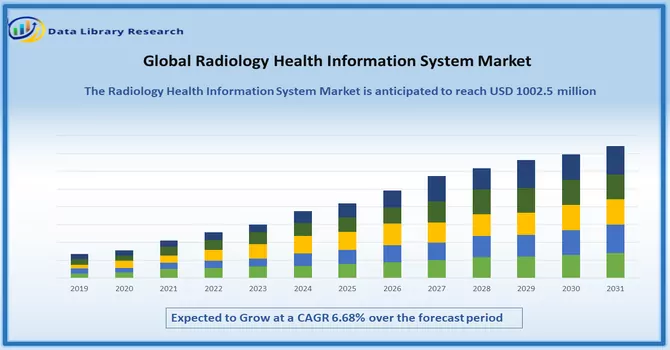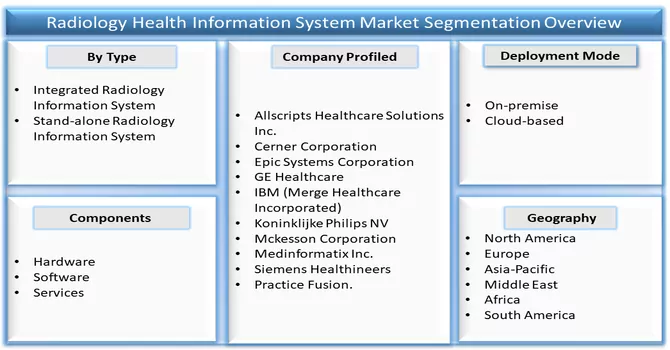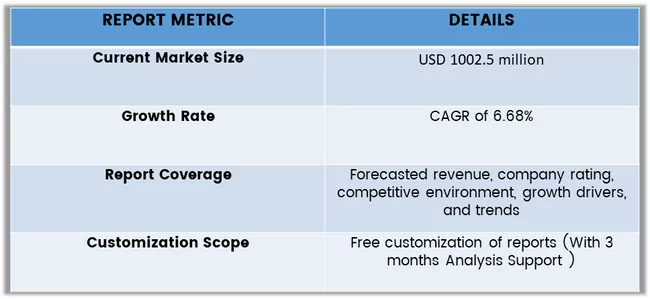The Radiology Information System Market is currently valued at USD 1002.5 million and is expected to register a CAGR of 6.68% over the forecast period, reaching a value of USD 1576.7 million over the forecast period.

Get Complete Analysis Of The Report - Download Free Sample PDF
A radiology information system (RIS) is a networked software system for managing medical imagery and associated data. A RIS is especially useful for tracking radiology imaging orders and billing information and is often used in conjunction with PACS and VNAs to manage image archives, record-keeping, and billing.
The market is expected to grow due to the increasing population, rising number of radiology professionals and practices, investments in R&D activities, and preference for cloud-based solutions. Moreover, the number of patients suffering from chronic diseases such as cancer, COPD, arthritis, osteoporosis, and others has increased significantly in recent years. This is increasing the demand for medical imaging which in turn is driving the radiology information system (RIS) market growth.
Segmentation :
The Radiology Information System Market is Segmented
By Type :
Deployment Mode :
Components :
Geography
The report offers the value (in USD million) for the above segments.

For Detailed Market Segmentation - Download Free Sample PDF
Market Driver:
Improved Healthcare Information Technology Systems
Radiology can use information technology (IT) in four major fields: namely, the management of workflow, the interpretation of images, treatment decision-making, and communication with clinicians and patients. Through the introduction of new technologies, such as the World Wide Web, wireless connectivity, and, more recently, social networks, significant progress has been made in the way radiological services can be delivered. Also, a growing number of electronic devices and sensors are becoming connected to the Internet and gradually shaping the Internet of Things (IoT). This IoT enables real-time collection of an enormous amount of autonomous, health-related data, even on a global scale. Those wireless “smart wearables” can be used for a wide variety of health-related purposes, such as monitoring heart rate, body temperature, mobility, and sugar levels. Furthermore, an article published in the Journal of Radiology in August 2022, reported that the role of artificial intelligence (AI) in clinical practice evolves, governance structures oversee the implementation, maintenance, and monitoring of clinical AI algorithms have significantly increased to enhance quality, manage resources, and ensure patient safety.
Growth in the Incidence Rate of Chronic Diseases
According to the data published by Globocan in 2020, reported an estimated 19,292,789 new cancer cases and 9,958,133 deaths due to cancers were reported in 2020 worldwide. An increase in cancer cases will lead to an increase in focus on radiology services for proper diagnosis, which is expected to drive the market demand for radiology information systems. The increasing incidence rate of chronic diseases like cancer is driving the demand for radiology information systems in the market.
Market Restraints:
Increase in Government Funding for Cancer-related Research
As per data published by Cancer Research UK in 2022, reported that in the financial year 2021/2022 the funding by the Government of UK included EUR 193 million on research projects focusing on specific cancers and EUR 79 million on research that underpins all cancers. The government is urgently prioritizing improving imaging services in England/UK, to detect cancer in scans and radiography, as a result, the demand for radiology services in the country is significantly increasing, thereby contributing to the growth of the studied market.
High Cost of the Installation and Lack of Skill Labour
An article published by National Center for Biotechnology Information in January 2021, reported that the average cost of installing an imaging machine varies somewhere between USD 200 billion and USD 250 billion a year in the healthcare system. Another document published by the Royal College of Radiologists in June 2023, reported that the UK has a 29% shortfall of skilled clinical radiologists, which will rise to 40% in five years without action. Thus, such a high cost of imaging instruments and lack of skilled labor may lead to mismanagement of radiology machines, thereby expected to slow down the growth of the studied market.
The COVID-19 pandemic impacted the growth of global radiology services, thereby has impacted the radiology information technology market. For instance, an article published by the British Journal of Radiology in October 2022, reported that radiology (primarily chest radiography and CT) has played a pivotal role in managing the pandemic in countries with well-developed healthcare systems, enabling early diagnosis, triage of patients likely to require intensive care and detection of arterial and venous thrombosis complicating the disease.
Segmental Analysis The Cloud-based Segment is Expected to Witness High Growth over the Forecast Period
The modernization of operations and approaches by utilizing technology solutions, such as radiology information systems and analytical sources, has significantly improved healthcare organizations and facilities. Images and reports are now being transmitted digitally via PACS (Picture archiving and communication system) by integrating the system with the radiology information system (RIS) and hospital information system (HIS). This integration eliminates the need to manually store, retrieve, and display film jackets. Given these benefits, most healthcare systems are shifting toward the adoption of radiology information systems, which is expected to drive market growth over the forecast period.
North America is Expected to Hold a Significant Market Share Over the Forecast Period
North America is expected to hold a major market share in the radiology information systems market due to increasing cases of chronic diseases and rising healthcare expenditure. Also, the presence of major companies is leading to the launch of new products in the region, thereby driving the growth of the studied market in the region. For instance, in July 2021, FUJIFILM Medical Systems U.S.A, Inc. reported that the next-generation Synapse Enterprise Information System (EIS) had been selected by United States Radiology Specialists to drive efficient and high-quality patient care across its network. Synapse Radiology Information System (RIS) is a comprehensive workflow management solution designed to streamline physician communication, improve patient interaction, and alleviate the mentioned administrative burden for the outpatient imaging market.

Get Complete Analysis Of The Report - Download Free Sample PDF
The Radiology Information System Market is moderately competitive due to the presence of a few companies working globally and regionally. Some of the major players working in this market segment are
Key Players :
Recent Development
1) In March 2022, Intelerad Medical Systems launched the Enterprise Imaging and Informatics Suite at the 2022 Healthcare Information and Management Systems Society (HIMSS) Global Health Conference and Exhibition, which may provide radiologists with an emerging option for medical image management.
2) In February 2022, Carestream Health India launched the DRX Compass, an accurate, convenient, and configurable digital radiology solution designed to provide radiologists with a whole new level of efficiency.
Q1. How big is the Radiology Health Information System Market?
The Radiology Information System Market is currently valued at USD 1002.5 million and is expected to register a CAGR of 6.68% over the forecast period, reaching a value of USD 1576.7 million over the forecast period.
Q2. Which Region is expected to hold the higest Market share?
North America is expected to hold a major market share in the Radiology Information System Market
Q3. Which are the major companies in the Radiology Health Information System Market?
Allscripts Healthcare Solutions Inc., Cerner Corporation, Epic Systems Corporation and GE Healthcare are some of the companies.
Q4. What segments are covered in the Radiology Health Information System Market Report?
Radiology Health Information System Market Report covered segments like - By Type, Deployment mode, Components And Geography.
Data Library Research are conducted by industry experts who offer insight on industry structure, market segmentations technology assessment and competitive landscape (CL), and penetration, as well as on emerging trends. Their analysis is based on primary interviews (~ 80%) and secondary research (~ 20%) as well as years of professional expertise in their respective industries. Adding to this, by analysing historical trends and current market positions, our analysts predict where the market will be headed for the next five years. Furthermore, the varying trends of segment & categories geographically presented are also studied and the estimated based on the primary & secondary research.
In this particular report from the supply side Data Library Research has conducted primary surveys (interviews) with the key level executives (VP, CEO’s, Marketing Director, Business Development Manager and SOFT) of the companies that active & prominent as well as the midsized organization
FIGURE 1: DLR RESEARH PROCESS

Extensive primary research was conducted to gain a deeper insight of the market and industry performance. The analysis is based on both primary and secondary research as well as years of professional expertise in the respective industries.
In addition to analysing current and historical trends, our analysts predict where the market is headed over the next five years.
It varies by segment for these categories geographically presented in the list of market tables. Speaking about this particular report we have conducted primary surveys (interviews) with the key level executives (VP, CEO’s, Marketing Director, Business Development Manager and many more) of the major players active in the market.
Secondary ResearchSecondary research was mainly used to collect and identify information useful for the extensive, technical, market-oriented, and Friend’s study of the Global Extra Neutral Alcohol. It was also used to obtain key information about major players, market classification and segmentation according to the industry trends, geographical markets, and developments related to the market and technology perspectives. For this study, analysts have gathered information from various credible sources, such as annual reports, sec filings, journals, white papers, SOFT presentations, and company web sites.
Market Size EstimationBoth, top-down and bottom-up approaches were used to estimate and validate the size of the Global market and to estimate the size of various other dependent submarkets in the overall Extra Neutral Alcohol. The key players in the market were identified through secondary research and their market contributions in the respective geographies were determined through primary and secondary research.
Forecast Model
